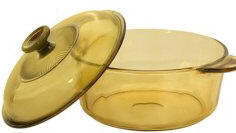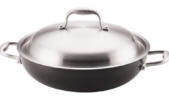|
Large, medium and small Covered Casserole dishes
With these three sizes you'll be able to cook all
manner of casseroles in varying quantities - from serves 8 to serves 1.
Lasagne dish
These
dishes are more shallow and wider making them suitable for all types of pasta
and vegetable bakes, especially those cooked for shorter periods and which
require a crisp or browned finish.
Â
Ramekins
Essential for making individual sized dishes such as
cr�me brul�e and savoury baked starters or individual
portions of p�t�s.
Â
Flame Proof Casserole Dish
Select a medium-sized flame proof casserole that can be
used on the stove top (flame proof not just heat proof), in the microwave as
well as in the oven.
Â
Flan dish
Select a 20cm/8-inch flan dish which will be large
enough for between 4 and 8 servings depending on the recipe. Suitable for
savoury quiches and sweet tarts and ideal for oven to table service.
Â
With these
seven items, you�ll be well on your way to a
well-stocked kitchen with all of the ovenware that you need to cook your
favourite meals.
Â
Back
to top
Â
Ovenware
comes in a wide variety of materials, which vary in their versatility, ease of
storage, longevity, effectiveness, and appearance. While some cooks love one
type of oven cookware, others may find a different material much easier or more
satisfying to work with. Before you invest heavily in a specific type of
cookware for your oven, it's a good idea to experiment to decide which you like
the best.Â
Â
Some of
your options include:
� Metal � From low-cost, practical, but short-lived aluminium to
high-tech and expensive titanium, you have plenty of options when it comes to
cookware for the oven. Stainless steel, cast iron, and copper are other popular
metallic materials.
� Glass � Tempered glass is lovely to work with and lets you see the food
as it cooks, which can really help you to improve your cooking. However, it can
also be temperamental, shattering easily if dropped or misused.
� Earthenware � Clay ovenware has been very popular throughout the
history of mankind, and remains so today. Earthenware is usually glazed, to
prevent foods from reacting with the clay and to ensure that there is no muddy
taste. Clay cookware holds heat well, which makes it ideal for casseroles and
other long, slow-cooking meals. However, it is very sensitive to sudden changes
in temperature and can break if heated or cooled too suddenly.
Article provided courtesy of Only Cookware - a resource for
pots and pans,
stainless cookware and
enamel cast iron cookware.
in conjunction with
Recipes4us
 |



